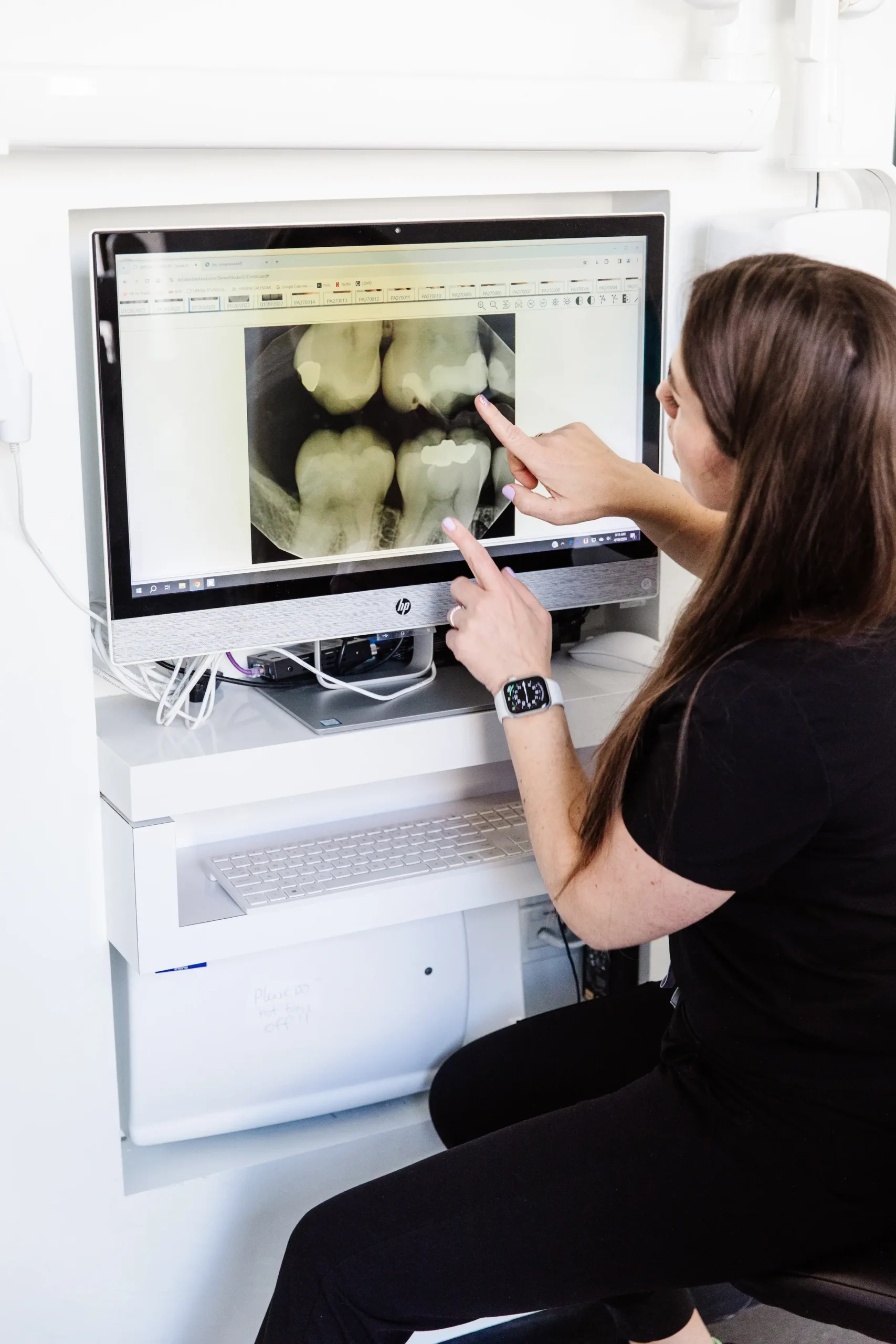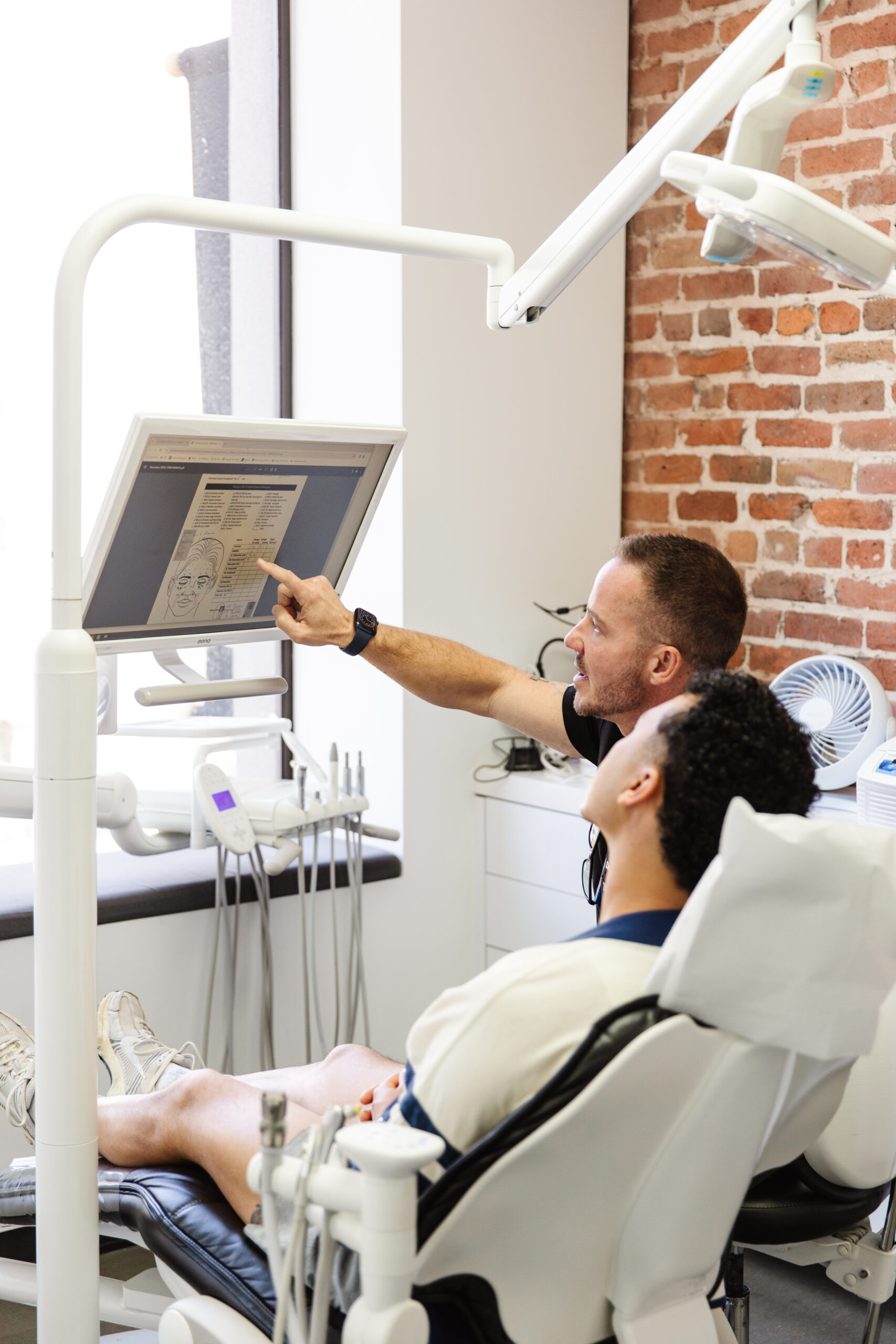TMJ & Orofacial Pain Management
Find Relief from Jaw Discomfort and Tension
Jaw pain, daily headaches, facial tension, unexplained earaches – sound familiar? We understand how frustrating and exhausting these symptoms can be, but relief is possible.
At Dental Studio SF, we offer modern, minimally invasive therapies to ease pain and support long-term jaw health.
We assess the root causes and offer treatment to alleviate the source – not just the symptoms – so you can finally relax again.
Understanding TMJ Disorders
The temporomandibular joints (TMJs) connect your jaw to your skull and allow you to speak, chew, and yawn. When these joints – or the muscles around them – become strained, misaligned, or inflamed, it can lead to a condition called TMJ disorder or TMD (temporomandibular joint disorder).
These conditions affect jaw joint function and cause pain in the jaw, face, head, or neck.
What Causes TMJ Disorder?
TMD can develop for a number of reasons. Some of the most common causes include:
- → Chronic teeth grinding or clenching (bruxism)
- → Misaligned bite or jaw
- → Jaw injuries
- → Arthritis in the joint
- → Habitual chewing (gum, ice, pens) or nail-biting
- → Stress and muscle tension
Common Symptoms of TMJ
 Clicking or popping in the jaw
Clicking or popping in the jaw
 Jaw stiffness or locking
Jaw stiffness or locking
 Facial tenderness or pain
Facial tenderness or pain
 Tension headaches or migraines
Tension headaches or migraines
 Ear pain or ringing
Ear pain or ringing
 Difficulty chewing or opening your mouth wide
Difficulty chewing or opening your mouth wide
Our TMJ & Orofacial Pain Treatments
We take a holistic approach to managing TMJ disorders. Here’s how we can help:
BOTOX® for TMJ Relief & Bruxism (Teeth Grinding)
BOTOX® isn’t just for aesthetics, it’s a powerful therapeutic tool for TMJ issues. By targeting overactive jaw muscles, BOTOX® can reduce clenching, grinding, and related pain.
Benefits include:
 Fast-acting relief
Fast-acting relief
 Reduced tension and muscle soreness
Reduced tension and muscle soreness
 Improved range of motion
Improved range of motion
 Minimally invasive, with no downtime
Minimally invasive, with no downtime
 Fewer headaches
Fewer headaches
 Better sleep quality
Better sleep quality
Trigger Point Injections for Myofascial Pain
Myofascial pain syndrome involves tight, sensitive spots in the muscles (trigger points) that cause jaw, head, or neck pain. We use targeted injections to release these points and relieve discomfort.
It’s a quick in-office procedure that provides pain relief without long-term medication.
Low-Level Laser Therapy (Photobiomodulation)
This cutting-edge therapy uses specific wavelengths of light to reduce inflammation and promote healing in soft tissues
Ideal for:
 Jaw pain and stiffness
Jaw pain and stiffness
 Muscle recovery
Muscle recovery
 Reducing inflammation naturally
Reducing inflammation naturally
Night Guards or Custom Orthotic Appliances
We can also treat your TMD with a more conservative approach – our custom orthotic appliances (like night guards) are designed to correct jaw misalignment and relieve your nagging TMJ pain & symptoms. It can help to relax your jaw muscles and reduce pressure on your nerves, joints and other oral structures.
What to Expect at Your Visit
 Thorough Consultation: We begin by listening closely to your symptoms, your concerns, and your goals – we want to understand the full picture.
Thorough Consultation: We begin by listening closely to your symptoms, your concerns, and your goals – we want to understand the full picture.
 Advanced Imaging: When needed, we use low-radiation digital x-rays and 3D scans to get a detailed view of what’s going on beneath the surface.
Advanced Imaging: When needed, we use low-radiation digital x-rays and 3D scans to get a detailed view of what’s going on beneath the surface.
 In-Depth Diagnosis: We assess your jaw joints, bite alignment, and muscle function to pinpoint the true source of your discomfort.
In-Depth Diagnosis: We assess your jaw joints, bite alignment, and muscle function to pinpoint the true source of your discomfort.
 Personalized Treatment Plan: You’ll receive a care plan tailored to your lifestyle, comfort level, and unique needs. We’ll walk through every option with you.
Personalized Treatment Plan: You’ll receive a care plan tailored to your lifestyle, comfort level, and unique needs. We’ll walk through every option with you.
We believe in early intervention, gentle and minimally invasive solutions, and support that continues even after your appointment ends.
Trusted by Jaws Across San Francisco
At Dental Studio SF, TMJ treatment isn’t one-size-fits-all – it’s thoughtful, evidence-based, and always centered on you.
Dr. Jarrod Cornehl brings advanced training in orofacial pain and a deep understanding of joint, muscle, and bite relationships to every case. We combine leading-edge therapies like BOTOX®, laser treatments, and custom orthotics to create a personalized, lasting path to relief.
Start Your Path to Relief
Living with jaw pain or chronic facial tension is exhausting, we know – but there are solutions. Whether you’re newly experiencing symptoms or have been searching for answers for years, our team is here with care that works.
TMJ Treatment FAQs
Yes. When administered by trained professionals, BOTOX® is a well-established treatment for muscle-related TMJ issues.
Botox is commonly known for its cosmetic applications but has been found effective in treating TMJ disorders. It works by relaxing the muscles around the jaw, reducing the tension and pain associated with TMJ.
Most of our patients begin to notice an improvement in their symptoms within a few days to a week after the treatment. The full effect typically becomes evident within two weeks.
The effects of Botox for TMJ can last anywhere from three to six months. The duration varies from patient to patient, and repeat treatments may be necessary for sustained relief.
The frequency of treatments varies. Dr. Cornehl will assess your response to the initial treatment and recommend a schedule that best suits your needs.
It depends on your provider and policy. We’re happy to help you check coverage and explore financing if needed.
Many patients find relief with a combination of treatments, including BOTOX®, physical therapy, and laser therapy. We’ll create a plan that works for you.
At-Home Help for TMJ Issues
It may not be helpful to try TMJ exercises at the moment you experience TMJ pain and discomfort. But once the pain has subsided, there are specific strengthening exercises you can do to help prevent some of it from returning.
Place your thumb under your chin and your index finger on the ridge between your lower lip and chin. Gently push upward as you close your mouth.
With your thumb under your chin, open your mouth while pressing lightly against your thumb. Hold for a few seconds, then relax.
Start with your jaw relaxed and teeth slightly apart. Slowly open your mouth as wide as you can without pain, while looking upward. Hold, then gently close.
With teeth apart, shift your jaw to the right while looking left with your eyes. Hold, return to center, then repeat in the opposite direction.
TMJ tension is often linked to stress. Inhale for 5–10 seconds, then slowly exhale. Practicing mindful breathing can help calm your muscles and reduce flare-ups.






